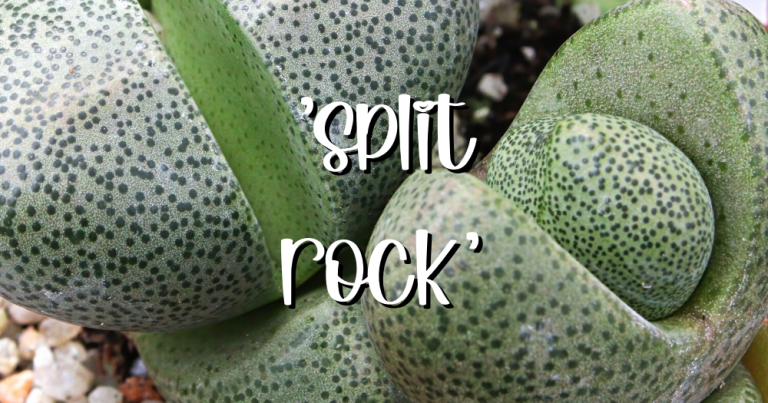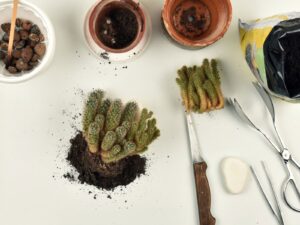When one encounters the peculiar charm of Pleiospilos nelii, or Split Rock, it is akin to stumbling upon an ancient secret concealed within a sun-baked landscape. This succulent, with its intriguing mimicry of stones and captivating morphology, is not merely a plant; it is a testament to nature’s artistry. Originating from the arid regions of South Africa, the Split Rock flourishes in harsh conditions, embodying resilience while offering a stunning display of botanical beauty. At the core of its allure lies a wealth of knowledge regarding its care and cultivation, an understanding that can elevate any succulent enthusiast’s garden.
Understanding the Anatomy: The Remarkable Structure of Split Rock
Pleiospilos nelii is celebrated for its rather unique structure—one that prompts admiration akin to gazing upon a sculptural masterpiece. The plant resembles a pair of split rocks, hence its evocative name. The leaves are thick and fleshy, often exhibiting a grayish-green hue with notable markings that mimic the look of stone. This adaptation is an evolutionary marvel, allowing it to evade herbivores while thriving in environments where moisture is scarce.
The Split Rock typically produces a single flower per year, a resplendent burst of yellow or orange, resembling a sun setting over the horizon. This flowering event adds a striking contrast to the otherwise subdued tones of its foliage and is often considered the crowning glory of the plant’s annual cycle.
Creating the Ideal Habitat: Emulating Its Native Environment
To cultivate a thriving Pleiospilos nelii, one must first acknowledge and replicate the environmental conditions of its indigenous habitat. These succulents prefer bright, indirect sunlight, reminiscent of the dappled light filtering through the South African savanna. Optimal growth is achieved with at least four to six hours of light daily, although direct, scorching sunlight can prove detrimental, particularly during the peak of summer.
Soil quality cannot be underestimated. A well-draining substrate is essential, as waterlogged roots can swiftly lead to rot. A potting mixture designed for cacti or a composition rich in perlite or pumice is ideal, mimicking the rocky terrain of its native home. Just as a craftsman selects the finest materials for their creation, so too must the grower choose the right soil blend for their plants.
Watering practices should reflect the principles of moderation. During the growing season, which typically spans spring and summer, a thorough watering should be administered when the soil has completely dried out. This cycle emulates the natural rainfalls that the Split Rock experiences in its arid environment, allowing the plant to hydrate and then rest between periods of moisture. In contrast, the winter months signal a period of dormancy, where watering should be significantly reduced. This adherence to seasonal rhythms ensures a flourishing plant, akin to a hibernating bear emerging robust after a long slumber.
Temperature and Humidity: A Balancing Act for Optimal Growth
The Split Rock thrives in temperatures that echo the warmth of its native biome. Ideally, daytime temperatures should hover around 70°F to 80°F (21°C to 27°C), while nighttime conditions can comfortably dip to 50°F (10°C). Such variations promote a healthy growth cycle, reminiscent of the natural ebb and flow of day and night in the wild. It is critical, however, to protect the plant from frost, as freezing temperatures can be catastrophic.
Humidity should also be kept in check. Pleiospilos nelii prefers a dry atmosphere, akin to the parched veldts of its native land, making it susceptible to fungal infections in higher humidity environments. A well-ventilated space that receives ample air circulation is essential for maintaining the health of this succulent.
Pest Management: Defending Against Nature’s Intruders
Even the most resilient of plants may face challenges in the form of pests. Aphids, mealybugs, and spider mites are among the common intruders that can infiltrate your Split Rock’s sanctuary. Vigilance is critical in detecting these unwanted guests. Regularly inspecting the underbelly of the leaves and surrounding soil can help identify early signs of infestation.
In instances where pests are detected, mild insecticidal soaps can serve as effective deterrents. This intervention mirrors nature’s own predator-prey dynamics, as one force seeks to reclaim dominance over another. Importantly, it is best to address infestations swiftly, as quick action can prevent the pests from wreaking havoc on the plant’s overall health.
Propagation: Cultivating New Life from the Parent Plant
The process of propagation serves as a bridge between generations, allowing the legacy of Pleiospilos nelii to endure. This succulent can be propagated through leaf cuttings, which should be allowed to callous over for several days before being placed in well-draining soil. As new roots form, it is akin to watching the cycle of life unfold, each new plant a testament to the resilience and beauty inherent in nature. Proper timing and care during this process can enable gardeners to expand their collections, opening the door to share the enticing world of succulents with others.
In Conclusion: An Enduring Companion for Your Botanical Journey
Pleiospilos nelii embodies a unique fusion of resilience and ethereal beauty. As you embark on the journey of cultivating this remarkable succulent, you will come to appreciate not only its captivating appearance but also the nuanced care that nurtures its growth. By mimicking its natural habitat, providing optimal conditions, and remaining vigilant against pests, you will foster an enduring companionship with one of nature’s most exquisite creations. The Split Rock is more than just a plant; it is an embodiment of perseverance, a living reminder of the beauty that can emerge from the harshest environments.





Leave a Comment